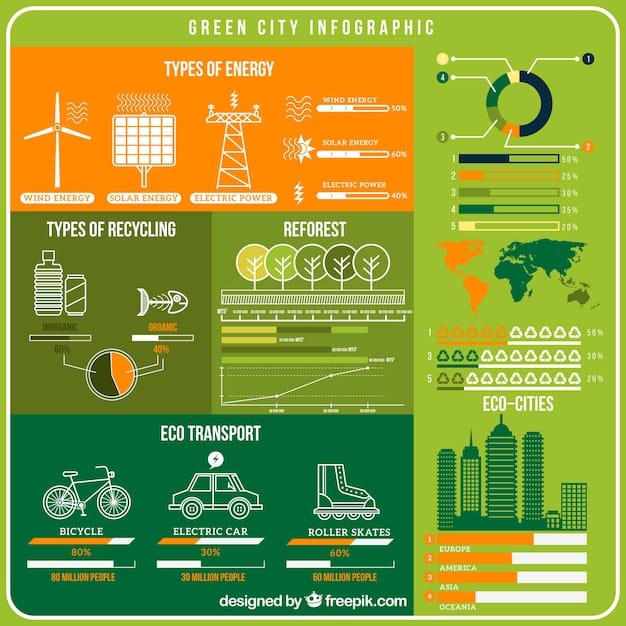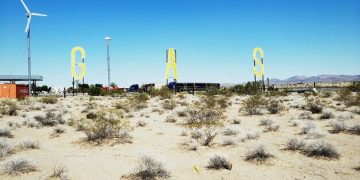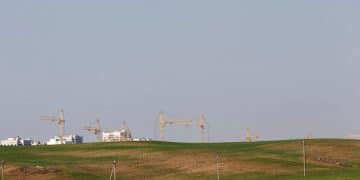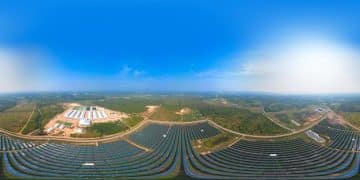Renewable Energy Surge: How 15% Growth Impacts US Grid Stability

The projected 15% increase in US renewable energy capacity by 2025 poses both opportunities and challenges for grid stability, requiring upgrades and innovative solutions to manage intermittency and ensure a reliable power supply.
The United States is on the cusp of a significant renewable energy boom, with projections indicating a 15% increase in capacity by 2025. But how will the projected 15% increase in US renewable energy capacity by 2025 impact grid stability? This surge brings great promise for reducing carbon emissions and diversifying our energy sources, but it also raises critical questions about the reliability and resilience of the power grid.
Understanding the US Renewable Energy Landscape
Renewable energy sources are becoming an increasingly important part of the US energy mix. As we move towards a more sustainable future, understanding the current landscape and projected growth of renewables is crucial. This section will explore the key players and technologies driving this change.
Current State of Renewable Energy in the US
The US has seen substantial growth in renewable energy sources over the past decade. Solar, wind, and hydropower are leading the charge, with significant contributions from biomass and geothermal energy. This growth is driven by factors like decreasing costs, supportive government policies, and increasing public awareness of climate change.
Projected Growth by 2025
The forecast of a 15% increase in renewable energy capacity by 2025 is ambitious but achievable. This growth is expected to be fueled primarily by solar and wind energy projects, driven by federal tax incentives and state-level renewable portfolio standards. These policies mandate that a certain percentage of electricity must come from renewable sources, promoting investment and development in the sector.

Here are some key factors contributing to this projected growth:
- Declining costs of solar and wind technologies.
- Federal and state government incentives.
- Increasing demand for clean energy solutions.
- Technological advancements in energy storage.
In summary, the US renewable energy landscape is dynamic and rapidly evolving. The projected 15% increase in capacity by 2025 reflects a broader trend towards a cleaner and more sustainable energy future, albeit one that necessitates careful consideration of grid stability.
The Challenge of Intermittency
One of the primary challenges in integrating renewable energy sources into the grid is their intermittent nature. Unlike traditional fossil fuel power plants, renewable sources like solar and wind depend on weather conditions, which can be unpredictable. This variability poses significant challenges for maintaining a stable and reliable grid.
Understanding Renewable Energy Intermittency
Intermittency refers to the variability of renewable energy generation. Solar power is only available during daylight hours, and its output can be reduced by cloud cover. Wind power depends on wind speed, which can fluctuate greatly. This variability makes it difficult to match energy supply with demand, potentially leading to blackouts or other grid disruptions.
Impact on Grid Reliability
The intermittent nature of renewable energy sources can significantly impact grid reliability. Grid operators must constantly balance supply and demand to maintain a stable frequency and voltage. Traditional power plants can quickly ramp up or down to meet changing demand, but renewable sources are less flexible. This makes it harder to maintain grid stability when renewable energy sources make up a large portion of the energy mix.
Key challenges related to intermittency include:
- Predicting renewable energy output accurately.
- Managing fluctuations in supply and demand.
- Ensuring sufficient backup generation capacity.
- Maintaining grid frequency and voltage stability.
In conclusion, addressing the challenge of intermittency is crucial for the successful integration of renewable energy into the US power grid. Innovative solutions like energy storage and grid modernization are needed to mitigate the impacts of variability and ensure a reliable energy supply.
Grid Modernization and Infrastructure Upgrades
To accommodate the increasing influx of renewable energy, significant investments in grid modernization and infrastructure upgrades are necessary. The current grid infrastructure was not designed to handle the variable output of renewable sources or the two-way flow of energy from distributed generation.
The Need for Smart Grids
Smart grids utilize advanced technologies to improve grid efficiency, reliability, and resilience. These technologies include sensors, data analytics, and automation, which enable grid operators to monitor and control the grid in real-time. Smart grids can also facilitate the integration of distributed generation, such as rooftop solar panels, by providing better visibility and control over energy flows.
Required Infrastructure Investments
Upgrading the grid infrastructure involves significant investments in transmission lines, substations, and energy storage facilities. New transmission lines are needed to transport renewable energy from remote areas, such as wind farms in the Midwest, to population centers. Substations need to be upgraded to handle the increased voltage and power flow. Energy storage facilities, such as batteries and pumped hydro storage, can help to smooth out the variability of renewable energy sources and provide backup power during periods of low generation.

Key areas for infrastructure investment include:
- Upgrading transmission and distribution networks.
- Deploying smart grid technologies.
- Investing in energy storage solutions.
- Improving grid monitoring and control systems.
In summary, grid modernization and infrastructure upgrades are essential for ensuring the successful integration of renewable energy sources into the US power grid. Smart grids and strategic investments in transmission, storage, and control systems can help to mitigate the challenges of intermittency and improve grid reliability.
Energy Storage Solutions
Energy storage plays a critical role in addressing the intermittency of renewable energy sources and ensuring grid stability. Energy storage technologies can store excess energy generated during periods of high renewable output and release it when demand is high or renewable generation is low. This helps to balance supply and demand and improve grid reliability.
Types of Energy Storage Technologies
There are several types of energy storage technologies, each with its own advantages and disadvantages. Battery storage is the most common type, with lithium-ion batteries being widely used for grid-scale applications. Pumped hydro storage involves pumping water uphill to a reservoir during periods of low demand and releasing it to generate electricity during periods of high demand. Other technologies include compressed air energy storage (CAES) and thermal energy storage.
Role in Grid Stabilization
Energy storage can play a vital role in grid stabilization by providing several key services. It can provide frequency regulation, which helps to maintain a stable grid frequency. It can provide voltage support, which helps to maintain a stable voltage level. It can also provide backup power during periods of low renewable generation or grid outages. By providing these services, energy storage can improve grid reliability and resilience.
Benefits of energy storage include:
- Mitigating the intermittency of renewable energy sources.
- Providing frequency regulation and voltage support.
- Enhancing grid reliability and resilience.
- Reducing the need for curtailment of renewable energy.
In conclusion, energy storage solutions are essential for the successful integration of renewable energy into the US power grid. Battery storage, pumped hydro storage, and other technologies can help to smooth out the variability of renewable energy sources and provide critical grid stabilization services.
Policy and Regulatory Frameworks
Government policies and regulatory frameworks play a crucial role in promoting the development and deployment of renewable energy and ensuring grid stability. Supportive policies can incentivize investment in renewable energy projects and grid infrastructure, while effective regulatory frameworks can ensure that these projects are integrated into the grid in a safe and reliable manner.
Federal and State Incentives
Federal and state incentives, such as tax credits, grants, and loan guarantees, can significantly reduce the cost of renewable energy projects and make them more economically viable. The federal Investment Tax Credit (ITC) for solar energy and the Production Tax Credit (PTC) for wind energy have been instrumental in driving growth in these sectors. State-level renewable portfolio standards (RPS) mandate that a certain percentage of electricity must come from renewable sources, creating a demand for renewable energy and incentivizing investment.
Regulatory Challenges
Integrating renewable energy into the grid also presents several regulatory challenges. Grid operators must develop new operating procedures to accommodate the variable output of renewable energy sources. Transmission planning processes must be updated to ensure that new transmission lines are built to transport renewable energy from remote areas to population centers. Interconnection standards must be developed to ensure that renewable energy projects can be connected to the grid safely and reliably.
Key policy and regulatory considerations include:
- Extending and expanding federal tax incentives for renewable energy.
- Strengthening state-level renewable portfolio standards.
- Streamlining the permitting process for renewable energy projects.
- Updating grid operating procedures and transmission planning processes.
In summary, supportive policies and effective regulatory frameworks are essential for promoting the development and deployment of renewable energy and ensuring grid stability. By incentivizing investment, addressing regulatory challenges, and fostering collaboration between stakeholders, governments can help to accelerate the transition to a cleaner and more sustainable energy future.
Future Trends and Innovations
The future of renewable energy and grid stability is likely to be shaped by emerging trends and innovative technologies. These include advancements in energy storage, smart grid technologies, and distributed energy resources. By embracing these innovations, the US can build a more resilient and sustainable energy system.
Emerging Technologies
Several emerging technologies hold great promise for improving grid stability and enabling greater integration of renewable energy. Advanced battery technologies, such as solid-state batteries and flow batteries, offer higher energy density, longer lifespans, and improved safety compared to traditional lithium-ion batteries. Smart grid technologies, such as advanced metering infrastructure (AMI) and distributed energy resource management systems (DERMS), can improve grid monitoring and control. Distributed energy resources (DERs), such as rooftop solar panels and microgrids, can provide local generation and reduce the strain on the central grid.
Long-Term Vision for Grid Stability
The long-term vision for grid stability involves a combination of centralized and distributed energy resources, interconnected by a smart and resilient grid. Centralized renewable energy projects, such as large-scale solar and wind farms, will continue to play a major role in supplying electricity. Distributed energy resources, such as rooftop solar panels and microgrids, will provide local generation and improve grid resilience. Smart grid technologies will enable grid operators to monitor and control the grid in real-time, optimizing energy flows and ensuring grid stability.
Key future trends and innovations include:
- Advancements in energy storage technologies.
- Deployment of smart grid technologies.
- Expanded adoption of distributed energy resources.
- Development of more resilient and flexible grid infrastructure.
In conclusion, the future of renewable energy and grid stability is bright, with many emerging trends and innovative technologies on the horizon. By embracing these innovations and investing in a smart and resilient grid, the US can build a more sustainable and reliable energy system for future generations.
| Key Point | Brief Description |
|---|---|
| ⚡ Intermittency Challenge | Renewable sources like solar and wind depend on weather, causing variability in energy supply. |
| 💡 Grid Modernization | Smart grids and infrastructure upgrades are needed to handle variable renewable energy output. |
| 🔋 Energy Storage | Battery and pumped hydro storage help balance supply and demand, stabilizing the grid. |
| 🏛️ Policy & Regulation | Government incentives and effective regulations are crucial for renewable energy growth and grid stability. |
Frequently Asked Questions
▼
The primary sources of renewable energy in the US are solar, wind, and hydropower. Biomass and geothermal energy also contribute, but to a lesser extent. Solar and wind are experiencing the most rapid growth.
▼
Intermittency causes variability in energy supply, making it difficult to match supply with demand. This can lead to fluctuations in grid frequency and voltage, potentially causing blackouts or other grid disruptions.
▼
A smart grid uses advanced technologies to improve grid efficiency, reliability, and resilience. It enables real-time monitoring and control, facilitating the integration of distributed generation and improving overall grid management.
▼
Common energy storage technologies include battery storage (especially lithium-ion), pumped hydro storage, compressed air energy storage (CAES), and thermal energy storage. These technologies store excess energy and release it when needed.
▼
Federal and state incentives like tax credits (ITC, PTC) and renewable portfolio standards (RPS) are key. Effective regulatory frameworks are also necessary to ensure safe and reliable grid integration.
Conclusion
The projected 15% increase in US renewable energy capacity by 2025 represents a significant step towards a cleaner energy future. However, integrating this influx of renewable energy requires careful planning, strategic investments in grid modernization, and innovative solutions to address the challenges of intermittency. By embracing these opportunities and overcoming the challenges, the US can build a more resilient, reliable, and sustainable energy system.





